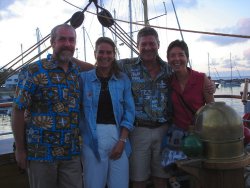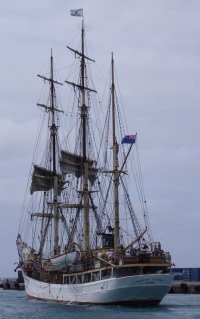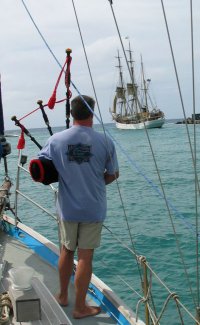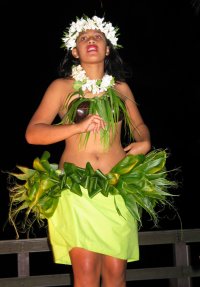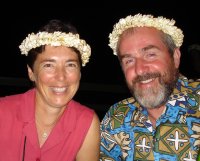 The
Cook Islands - September 2005
The
Cook Islands - September 2005
|
Cook Islands? - well maybe that should read Cook Island as we only visted the main island of Rarotonga. Time was running short (again!) and we still have a long way to go to get to Australia before the cyclone season begins. We arrived on 7 September after a fast five-day sail from Bora Bora and tied up to the dock Tahiti-style - you drop an anchor about 30 metres off the dock and then tie the stern up to the wall. |
|
Approaching Rarotonga. |
|
Nechtan in Avatiu Harbour.
|
|
The first thing that struck us as we stepped ashore was that the signs were in English. After a year in Spanish and French speaking countries, we could speak to people in English again! (The Cook Islands have close ties to New Zealand, but the locals also speak their own form of Maori.) Rarotonga suffered the onslaught of 5 cyclones in February and March this year - Meena, Nancy, Olaf, Percy and Rae. Although most businesses are now up and running again you can still see buildings that have not been repaired and some of the big resorts were only just re-opening when we there. Of course local fruit and vegetable production also suffered - for example, bananas were a real treat as there were virtually none available on the island - all the palms had been so damaged that this year's crop is a non-event.
|
|
|
The beach off Avarua town is strewn with coral boulders thrown up by this year's cyclones. |
|
|
While clearing in, the harbour master, on hearing Tom is Scottish, asked if he had bagpipes with him. Then he was straight onto the phone and we heard him say "Jimmy the Bruce? I've got a Scotsman here who wants to play the pipes with you!" and handed Tom the phone. It turns out Jim Bruce is a second-generation Scots exile - his father moved from Inverness to Hawaii in the 1920's. Jim owns a great wee beach hotel called the Aro'a Beachside Inn and we spent some time there in The Shipwreck Bar.
|
|
Gordon, Mary, Rochelle, Jim and Stephanie at the Shipwreck Bar. |
A sign in the Shipwreck Bar.
|
|
It was at Jim's place that we met Gordon (another Scot!) and Mary Potter. They have lived in a lot of places around the world and Rarotonga is the latest. Both Gordon and Jim play bagpipes and so a pipeband was immediately formed!
|
|
The Rarotonga Pipe Band. |
|
Gordon, Mary and Jim showed us great hospitality while we were on Rarotonga and were great fun. One Sunday afternoon Gordon and Mary drove us around the island (it's only 31 km) stopping at various resorts along the way. While doing this resort crawl we "chased" humpback whales along the west coast, watching them spouting on the far side of the reef as we sipped yummy cocktails and icy beers in the golden rays of the setting sun.... paradise, or what?! |
|
Another beer in paradise.... |
....and another one.
|
|
The government buildings in Avarua were badly damaged by a fire in 1992 and subsequently demolished. The nice new pink and white building has cyclone-resistant construction with the ground floor being open (shady parking!) and all offices on the one floor above. This structure provides more resistance to the destructive storm surge of a cyclone which otherwise washes most buildings away.
|
|
Got a boring warehouse wall?.... put a mural on it! |
Beside the new government buildings is the Seven-in-One coconut tree, planted in 1906.
|
|
Yummy desserts at our favourite cafe... |
...Cafe Salsa!
|
|
Tied up just down the dock from us was a big 3-masted barque called Picton Castle. Her home port is Rarotonga but she spends most of the time circumnavigating on an 18-month cycle. We were given a guided tour and met some of the crew. |
|
Us with friends Heike and Klaus from Filia Venti, onboard the Picton Castle. |
The Picton Castle leaving harbour.
|
|
Piping out the Picton Castle. |
The Picton Castle, built in 1928, is more traditional than most square-riggers still sailing today, in that she uses canvas sails and hemp ropes. Thankfully she does have modern marine toilets - Sue checked! It was a great sight as she set sail just outside the harbour. Their website is at www.picton-castle.com.
|
|
Another vessel which departed while we were there was Tournesol. She is crewed by a blind couple from the USA, Pam and Scott. Pam has 20% vision and Scott 10%. They plan to be the first registered blind people to sail across the Pacific and once they've done that, they want to complete a circumnavigation. Their quiet determination to follow a dream despite all the difficulties should be an inspiration to everyone. Follow their progress at www.blindsailing.com. |
Tournesol departs Avatiu Harbour. |
|
We also went to another Polynesian dance night, this time by a troupe from the island of Mangaia. Cook Islands dancing differs from Tahitian dancing only slightly - the girls move their hips side to side rather than in a circle. The band was a lively bunch and everyone, including us, had a great time! Tom bought some of the drummers a beer and got an ei (flower garland) plonked on his and Sue's head by way of thanks (he didn't wear it for long!).
|
|
|
|
|
|
|
|
This beer from Samoa is named after R. L. Stevenson's house. |
|
Throughout the South Pacific black pearls are a big business. They come from the Black-lipped Oyster which is indigenous to atolls of the Cook Islands and the lagoons of French Polynesia. A few centuries ago black pearl shell was sought after for inlaid furniture and buttons, as well as for royal jewellery. In recent years they have made a comeback in the world of high fashion. Despite their name the pearls are rarely just black as most have a multitude of iridescent hues through greens, pinks, blues and even golds. Needless to say we finally succombed and bought one for Sue! The only bad thing about Rarotonga was that unfortunately Sue contracted food poisoning, delaying our departure by a week while she took a course of antibiotics. But what a nice place to be delayed in! |
|
On the day we left, Gordon and Mary presented Sue with an ei, a ring of fragrant gardenia flowers. As tradition dictated, we threw a flower from the ei into the harbour as we departed, then hung the remainder in the cabin and had a beautiful smell for the passage to Tonga. Gordon and Mary also gave us a wooden carving of Tangaroa, Polynesian god of creation, fishing, the sea, carpentry, planting, the weather, and.... er, yes, he's also a fertility symbol! |
|
Sue and her ei. |
|
Tangaroa, god of short-legged men? |
|
Some coins of the Cook Islands. (Tangaroa is on the $1 coin.) |
|
Humpback Whale. |
As we sailed away from Rarotonga we were visited by a big humpback whale. Humpbacks visit the Pacific Islands during the Southern winter to calve and mate, before returning to their Antarctic feeding grounds for the summer. As we sailed westwards into the sunset, bound for Tonga, we listened to live whalesong, transmitted over the VHF by the Whale Research group - a magical departure. (Check out www.whaleresearch.org.)
|
